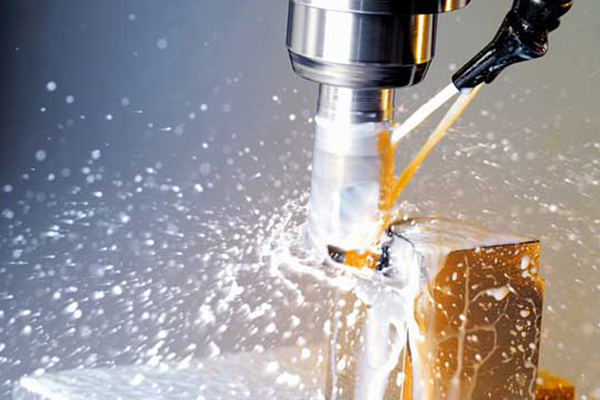2024-12-23 23:56:26
Cutting Fluid plays a vital role in the metalworking industry. Its main functions include cooling, lubrication, cleaning and rust prevention. The correct selection of Cutting Fluid can not only improve processing efficiency, but also extend tool life, ensure workpiece quality, and ensure operator safety and environmental sustainability. This article will introduce in detail how to choose the best cutting fluid for reference.

1. Understand the classification of cutting fluids
Cutting fluids are mainly divided into two categories: oil-based cutting fluids and water-based cutting fluids. Water-based cutting fluids are further subdivided into emulsified cutting fluids, semi-synthetic cutting fluids and fully synthetic cutting fluids.
Oil-based cutting fluids
Mineral oil cutting fluids: mainly composed of mineral oils (such as kerosene, diesel or light oil), animal and vegetable oils, fatty acids, extreme pressure additives, rust inhibitors, etc. can be added to provide good lubrication performance, but the cooling performance is relatively weak.
Extreme pressure Cutting Oil: contains extreme pressure additives such as sulfur, phosphorus, and chlorine, suitable for high-load cutting processing, can withstand shear stress under high temperature and high pressure, and provide excellent boundary lubrication.
Active Cutting Oil: contains compounds such as active sulfur, which can form a special chemical reaction film on the metal surface to enhance the lubrication effect.
Water-based cutting fluid
Emulsified cutting fluid: Based on mineral oil, it is mixed with water in a certain proportion to form an emulsion, and rust inhibitors, lubricants and surfactants are added. It can be divided into ordinary emulsions, rust-proof emulsions and extreme pressure emulsions.
Semi-synthetic cutting fluid: contains a certain proportion (usually less than 50%) of mineral oil and synthetic compounds, combining the advantages of oil-based and fully synthetic cutting fluids, with good lubrication, cooling and rust prevention performance, and better biological stability.
Fully synthetic cutting fluid: does not contain mineral oil, is completely made of water-soluble synthetic compounds, has strong cooling performance, good biological stability, does not contain harmful substances, and is suitable for environmentally friendly and high-performance occasions.
2. Consider the processing material
The selection of cutting fluid should first consider the type of processing material. Different materials have different requirements for cutting fluids.
Cast iron and steel: Oil-based cutting fluids are usually selected because they have higher requirements for lubrication performance.
Aluminum alloy and stainless steel: Water-based cutting fluids are usually selected for easily oxidized materials, especially those that provide good cooling performance to prevent overheating and oxidation of the workpiece.
Other special materials: such as titanium alloys and composite materials, require specific types of cutting fluids, such as high-performance synthetic cutting fluids, to ensure good processing results.
3. Consider cutting type and processing conditions
Cutting type (such as drilling, milling, turning, etc.) and processing conditions (such as cutting speed, feed rate, cutting depth) also directly affect the selection of cutting fluids.
Drilling: The cutting fluid needs to have good cooling and lubrication properties to reduce friction and heat accumulation.
Milling: The cutting fluid is required to have good flushing properties to effectively remove chips and heat.
High-speed cutting: The cutting fluid is usually required to provide excellent cooling and lubrication properties at the same time to prevent tool wear and workpiece deformation.
4. Consider environmental requirements and cost-effectiveness
When choosing cutting fluids, environmental requirements and cost-effectiveness also need to be considered.
Environmental requirements: Modern cutting fluids must meet environmental standards and do not contain harmful substances such as heavy metals and chlorine. More and more companies pay attention to the use of environmentally friendly cutting fluids to reduce pollution to the environment.
Cost-effectiveness: The cost of cutting fluids includes purchase cost, use cost, treatment cost and recycling cost. Consider the performance and price of cutting fluids comprehensively, and choose products with high cost performance to optimize the overall processing cost.
5. Consider the performance indicators of cutting fluids
The performance indicators of cutting fluids include cooling performance, lubrication performance, antibacterial performance, anti-rust performance, etc. According to specific processing requirements, choose cutting fluids with appropriate performance indicators.
Cooling performance: Good cooling performance can prevent overheating of workpieces and extend tool life.
Lubrication performance: Good lubrication performance can reduce friction and improve processing efficiency.
Antibacterial performance: Prevent cutting fluids from deteriorating and bacterial growth during use.
Antirust performance: Protect the processed workpieces from corrosion.
6. Consider the stability and cleanliness of cutting fluids
The stability and cleanliness of cutting fluids are also important selection factors.
Stability: Stable cutting fluids can maintain consistent performance during processing, extend service life, and reduce replacement frequency.
Cleanliness: The cleanliness of cutting fluids is related to their ability to remove chips and metal dust. Selecting a cutting fluid with good cleanliness can reduce the accumulation of chips and the pollution of the cutting fluid, and improve the processing quality.
VII. Application methods of cutting fluid
The main application methods of cutting fluid are pouring method, high-pressure cooling method and spray cooling method.
Pouring method: the most used, but the flow rate is slow, the pressure is low, and the effect is relatively poor.
High-pressure cooling method: spraying cutting fluid to the cutting area through high pressure and large flow rate, especially suitable for deep hole processing and difficult-to-cut materials, with significant effect.
Spray cooling method: similar to high-pressure cooling method, but the spraying method is more refined, suitable for high-speed cutting and precision processing.
VIII. Consulting suppliers and conducting tests
When selecting cutting fluid, you can consult cutting fluid suppliers or professionals and choose according to specific needs. At the same time, conduct tests and evaluations to ensure that the selected cutting fluid can meet the processing requirements.
In summary, the selection of the best cutting fluid requires comprehensive consideration of multiple factors such as processing materials, cutting types, processing conditions, environmental requirements, cost-effectiveness, performance indicators, stability and cleanliness. Through scientific selection and correct application methods, the role of cutting fluid can be fully utilized, processing efficiency and workpiece quality can be improved, and the safety of operators and environmental sustainability can be guaranteed.